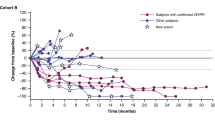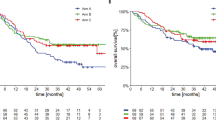Abstract
After decades of stagnation, recent therapeutic advances in melanoma seem on the horizon. The discovery of the genetic underpinnings of this historically refractory disease has exposed potential targets for therapy, BRAF mutations being principal among them. In the 8 years following the discovery of BRAF mutations in 50–60% of advanced melanomas, only recently have potent and selective inhibitors of this intracellular signaling molecule shown efficacy from early clinical testing. Vemurafenib (PLX4032) and GSK2118436, two orally available and well tolerated agents are on the verge of transforming the landscape of melanoma therapy based on the promising results of their respective phase I, II, and III trials.
Key Points
-
BRAF is the most frequently mutated oncogene in melanoma
-
Selective BRAF inhibitors have produced tumor regression in the vast majority of patients with metastatic melanoma whose tumors harbor activating BRAF mutations
-
Selective BRAF inhibitors are associated with the appearance of keratinocyte proliferations in patients; upregulation of the MAPK pathway in normal cells observed in vitro may explain this observation
-
Additional oncogenic events are associated with BRAF mutations and may provide rational additional targets for combination therapy
-
Preliminary evidence suggests that selective BRAF inhibitors may complement immunotherapy by upregulating antigen expression but without inhibiting T-cell function
This is a preview of subscription content, access via your institution
Access options
Subscribe to this journal
Receive 12 print issues and online access
$209.00 per year
only $17.42 per issue
Buy this article
- Purchase on Springer Link
- Instant access to full article PDF
Prices may be subject to local taxes which are calculated during checkout



Similar content being viewed by others
References
Padua, R. A., Barrass, N. & Currie, G. A. A novel transforming gene in a human malignant melanoma cell line. Nature 311, 671–673 (1984).
Davies, H. et al. Mutations of the BRAF gene in human cancer. Nature 417, 949–954 (2002).
Gray-Schopfer, V., Wellbrock, C. & Marais, R. Melanoma biology and new targeted therapy. Nature 445, 851–857 (2007).
Haluska, F. G. et al. Genetic alterations in signaling pathways in melanoma. Clin. Cancer Res. 12, 2301s–2307s (2006).
Curtin, J. A. et al. Distinct sets of genetic alterations in melanoma. N. Engl. J. Med. 353, 2135–2147 (2005).
Wellcome Trust Sanger Institute Catalog of Somatic Mutations in Cancer [online], (2011).
Wan, P. T. et al. Mechanism of activation of the RAF-ERK signaling pathway by oncogenic mutations of B-RAF. Cell 116, 855–867 (2004).
Smalley, K. S. et al. CRAF inhibition induces apoptosis in melanoma cells with non-V600E BRAF mutations. Oncogene 28, 85–94 (2009).
Uribe, P., Wistuba, I. I. & González, S. BRAF mutation: a frequent event in benign, atypical, and malignant melanocytic lesions of the skin. Am. J. Dermatopathol. 25, 365–370 (2003).
Dong, J. et al. BRAF oncogenic mutations correlate with progression rather than initiation of human melanoma. Cancer Res. 63, 3883–3885 (2003).
Eisen, T. et al. Sorafenib in advanced melanoma: a phase II randomised discontinuation trial analysis. Br. J. Cancer 95, 581–586 (2006).
Solit, D. B. et al. BRAF mutation predicts sensitivity to MEK inhibition. Nature 439, 358–362 (2006).
Rinehart, J. et al. Multicenter phase II study of the oral MEK inhibitor, CI-1040, in patients with advanced non-small-cell lung, breast, colon, and pancreatic cancer. J. Clin. Oncol. 22, 4456–4462 (2004).
Lorusso, P. et al. A phase 1–2 clinical study of a second generation oral MEK inhibitor, PD 0325901 in patients with advanced cancer [abstract]. J. Clin. Oncol. 23 (Suppl.), a3011 (2005).
Dankort, D. et al. Braf(V600E) cooperates with Pten loss to induce metastatic melanoma. Nat. Genet. 41, 544–552 (2009).
Michailidou, C. et al. Dissecting the roles of Raf- and PI3K-signalling pathways in melanoma formation and progression in a zebrafish model. Dis. Model Mech. 2, 399–411 (2009).
Dhomen, N. et al. Oncogenic Braf induces melanocyte senescence and melanoma in mice. Cancer Cell 15, 294–303 (2009).
Hoeflich, K. P. et al. Oncogenic BRAF is required for tumor growth and maintenance in melanoma models. Cancer Res. 66, 999–1006 (2006).
Flaherty, K. T. et al. Inhibition of mutated, activated BRAF in metastatic melanoma. N. Engl. J. Med. 363, 809–819 (2010).
Kefford, R. et al. Phase I/II study of GSK2118436, a selective inhibitor of oncogenic mutant BRAF kinase, in patients with metastatic melanoma and other solid tumors [abstract]. J. Clin. Oncol. 28 (Suppl.), a8503 (2010).
Bollag, G. et al. Clinical efficacy of a RAF inhibitor needs broad target blockade in BRAF-mutant melanoma. Nature 467, 596–599 (2010).
King, A. J. et al. Demonstration of a genetic therapeutic index for tumors expressing oncogenic BRAF by the kinase inhibitor SB-590885. Cancer Res. 66, 11100–11105 (2006).
Fischer, A. et al. Regulation of RAF activity by 14-3-3 proteins: RAF kinases associate functionally with both homo- and heterodimeric forms of 14-3-3 proteins. J. Biol. Chem. 284, 3183–3194 (2009).
Hall-Jackson, C. A. et al. Paradoxical activation of Raf by a novel Raf inhibitor. Chem. Biol. 6, 559–568 (1999).
Balmain, A., Ramsden, M., Bowden, G. T. & Smith, J. Activation of the mouse cellular Harvey-ras gene in chemically induced benign skin papillomas. Nature 307, 658–660 (1984).
Quintanilla, M., Brown, K., Ramsden, M. & Balmain, A. Carcinogen-specific mutation and amplification of Ha-ras during mouse skin carcinogenesis. Nature 322, 78–80 (1986).
Hatzivassiliou, G. et al. RAF inhibitors prime wild-type RAF to activate the MAPK pathway and enhance growth. Nature 464, 431–435 (2010).
Heidorn, S. J. et al. Kinase-dead BRAF and oncogenic RAS cooperate to drive tumor progression through CRAF. Cell 140, 209–221 (2010).
Poulikakos, P. I., Zhang, C., Bollag, G., Shokat, K. M. & Rosen, N. RAF inhibitors transactivate RAF dimers and ERK signalling in cells with wild-type BRAF. Nature 464, 427–430 (2010).
Joseph, E. W. et al. The RAF inhibitor PLX4032 inhibits ERK signaling and tumor cell proliferation in a V600E BRAF-selective manner. Proc. Natl Acad. Sci. USA 107, 14903–14908 (2010).
Infante, J. R. et al. Safety and efficacy results from the first-in-human study of the oral MEK 1/2 inhibitor GSK1120212 [abstract]. J. Clin. Oncol. 28 (Suppl.), a2503 (2010).
Dummer, R. et al. AZD6244 (ARRY-142886) vs temozolomide (TMZ) in patients (pts) with advanced melanoma: an open-label, randomized, multicenter, phase II study [abstract]. J. Clin. Oncol. 26 (Suppl.), a9033 (2008).
Druker, B. J. et al. Efficacy and safety of a specific inhibitor of the BCR-ABL tyrosine kinase in chronic myeloid leukemia. N. Engl. J. Med. 344, 1031–1037 (2001).
Demetri, G. D. et al. Efficacy and safety of imatinib mesylate in advanced gastrointestinal stromal tumors. N. Engl. J. Med. 347, 472–480 (2002).
Lynch, T. J. et al. Activating mutations in the epidermal growth factor receptor underlying responsiveness of non-small-cell lung cancer to gefitinib. N. Engl. J. Med. 350, 2129–2139 (2004).
Kwak, E. L. et al. Anaplastic lymphoma kinase inhibition in non-small-cell lung cancer. N. Engl. J. Med. 363, 1693–1703 (2010).
Paraiso, K. H. et al. Recovery of phospho-ERK activity allows melanoma cells to escape from BRAF inhibitor therapy. Br. J. Cancer 102, 1724–1730 (2010).
Sosman, J. et al. An open-label, multicenter phase II study of continuous oral dosing of RG7204 (PLX4032) in previously treated patients with BRAF V600E mutation-positive metastatic melanoma [abstract 30]. Pigment Cell Melanoma Res. 23 (Suppl.), 912 (2010).
Roche. Media release: Roche personalized investigational medicine shows survival benefit in advanced skin cancer [online], (2011).
Kopetz, S. et al. PLX4032 in metastatic colorectal cancer patients with mutant BRAF tumors [abstract]. J. Clin. Oncol. 28 (Suppl.), a3534 (2010).
Lee, W. et al. The mutation spectrum revealed by paired genome sequences from a lung cancer patient. Nature 465, 473–477 (2010).
Wellbrock, C. et al. Oncogenic BRAF regulates melanoma proliferation through the lineage specific factor MITF. PLoS One 3, e2734 (2008).
Garraway, L. A. & Sellers, W. R. Lineage dependency and lineage-survival oncogenes in human cancer. Nat. Rev. Cancer 6, 593–602 (2006).
Nazarian, R. et al. Melanomas acquire resistance to B-RAF(V600E) inhibition by RTK or N-RAS upregulation. Nature 468, 973–977 (2010).
Villanueva, J. et al. Acquired resistance to BRAF inhibitors mediated by a RAF kinase switch in melanoma can be overcome by cotargeting MEK and IGF-1R/PI3K. Cancer Cell 18, 683–695 (2010).
Johannessen, C. M. et al. COT drives resistance to RAF inhibition through MAP kinase pathway reactivation. Nature 468, 968–972 (2010).
Shah, N. P. et al. Multiple BCR-ABL kinase domain mutations confer polyclonal resistance to the tyrosine kinase inhibitor imatinib (STI571) in chronic phase and blast crisis chronic myeloid leukemia. Cancer Cell 2, 117–125 (2002).
Søndergaard, J. N. et al. Differential sensitivity of melanoma cell lines with BRAFV600E mutation to the specific Raf inhibitor PLX4032. J. Transl. Med. 8, 39 (2010).
Montagut, C. et al. Elevated CRAF as a potential mechanism of acquired resistance to BRAF inhibition in melanoma. Cancer Res. 68, 4853–4861 (2008).
Gray-Schopfer, V. C., Karasarides, M., Hayward, R. & Marais, R. Tumor necrosis factor-alpha blocks apoptosis in melanoma cells when BRAF signaling is inhibited. Cancer Res. 67, 122–129 (2007).
Goel, V. K., Lazar, A. J., Warneke, C. L., Redston, M. S. & Haluska, F. G. Examination of mutations in BRAF, NRAS, and PTEN in primary cutaneous melanoma. J. Invest. Dermatol. 126, 154–160 (2006).
Smalley, K. S. et al. Multiple signaling pathways must be targeted to overcome drug resistance in cell lines derived from melanoma metastases. Mol. Cancer Ther. 5, 1136–1144 (2006).
Hodi, F. S. et al. Improved survival with ipilimumab in patients with metastatic melanoma. N. Engl. J. Med. 363, 711–723 (2010).
Tsao, H., Atkins, M. B. & Sober, A. J. Management of cutaneous melanoma. N. Engl. J. Med. 351, 998–1012 (2004).
Hunder, N. N. et al. Treatment of metastatic melanoma with autologous CD4+ T cells against NY-ESO-1. N. Engl. J. Med. 358, 2698–2703 (2008).
Rosenberg, S. A., Restifo, N. P., Yang, J. C., Morgan, R. A. & Dudley, M. E. Adoptive cell transfer: a clinical path to effective cancer immunotherapy. Nat. Rev. Cancer 8, 299–308 (2008).
Schumacher, L. Y. et al. Immunosensitization of tumor cells to dendritic cell-activated immune responses with the proteasome inhibitor bortezomib (PS-341, Velcade). J. Immunol. 176, 4757–4765 (2006).
Begley, J. & Ribas, A. Targeted therapies to improve tumor immunotherapy. Clin. Cancer Res. 14, 4385–4391 (2008).
Kono, M. et al. Role of the mitogen-activated protein kinase signaling pathway in the regulation of human melanocytic antigen expression. Mol. Cancer Res. 4, 779–792 (2006).
Boni, A. et al. Selective BRAFV600E inhibition enhances T-cell recognition of melanoma without affecting lymphocyte function. Cancer Res. 70, 5213–5219 (2010).
Berridge, M. J. Lymphocyte activation in health and disease. Crit. Rev. Immunol. 17, 155–178 (1997).
Comin-Anduix, B. et al. The oncogenic BRAF kinase inhibitor PLX4032/RG7204 does not affect the viability or function of human lymphocytes across a wide range of concentrations. Clin. Cancer Res. 16, 6040–6048 (2010).
Author information
Authors and Affiliations
Contributions
K. T. Flaherty was responsible for researching the data for this article. Both authors were involved in discussing the article content, writing the article and revising the manuscript throughout the submission process.
Corresponding author
Ethics declarations
Competing interests
Antoni Ribas declares he is a consultant for Genentech Roche. Keith T. Flaherty declares he is a consultant for Genentech Roche and GlaxoSmithKline.
Rights and permissions
About this article
Cite this article
Ribas, A., Flaherty, K. BRAF targeted therapy changes the treatment paradigm in melanoma. Nat Rev Clin Oncol 8, 426–433 (2011). https://doi.org/10.1038/nrclinonc.2011.69
Published:
Issue Date:
DOI: https://doi.org/10.1038/nrclinonc.2011.69
This article is cited by
-
Logic-based modeling and drug repurposing for the prediction of novel therapeutic targets and combination regimens against E2F1-driven melanoma progression
BMC Chemistry (2023)
-
AK2 is an AMP-sensing negative regulator of BRAF in tumorigenesis
Cell Death & Disease (2022)
-
Massively parallel sequencing analysis of 68 gastric-type cervical adenocarcinomas reveals mutations in cell cycle-related genes and potentially targetable mutations
Modern Pathology (2021)
-
Treatment Sequencing and Clinical Outcomes in BRAF-Positive and BRAF-Negative Unresectable and Metastatic Melanoma Patients Treated with New Systemic Therapies in Routine Practice
Targeted Oncology (2019)
-
Molecular testing for BRAF mutations to inform melanoma treatment decisions: a move toward precision medicine
Modern Pathology (2018)



